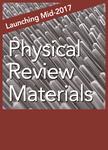版权所有:内蒙古大学图书馆 技术提供:维普资讯• 智图
内蒙古自治区呼和浩特市赛罕区大学西街235号 邮编: 010021

作者机构:Department of Materials Science and Engineering Northwestern University Evanston Illinois 60208 USA Computation Institute University of Chicago Chicago Illinois 60637 USA Department of Electrical Engineering and Computer Science Northwestern University Evanston Illinois 60208 USA
出 版 物:《Physical Review Materials》 (Physic. Rev. Mat.)
年 卷 期:2018年第2卷第12期
页 面:123801-123801页
核心收录:
基 金:U. S. Department of Commerce National Science Foundation, NSF National Institute of Standards and Technology, NIST Center for Hierarchical Materials Design, CHiMaD National Science Foundation, NSF, (ACI-1548562) National Science Foundation, NSF Toyota Physical and Chemical Research Institute, TPCRI, (70NANB14H012) Toyota Physical and Chemical Research Institute, TPCRI
主 题:Density functional theory High-throughput calculations
摘 要:Discovering novel, multicomponent crystalline materials is a complex task owing to the large space of feasible structures. Here we demonstrate a method to significantly accelerate materials discovery by using a machine learning (ML) model trained on density functional theory (DFT) data from the Open Quantum Materials Database (OQMD). Our ML model predicts the stability of a material based on its crystal structure and chemical composition, and we illustrate the effectiveness of the method by application to finding new quaternary Heusler (QH) compounds. Our ML-based approach can find new stable materials at a rate 30 times faster than undirected searches and we use it to predict 55 previously unknown, stable QH compounds. We find the accuracy of our ML model is higher when trained using the diversity of crystal structures available in the OQMD than when training on well-curated datasets which contain only a single family of crystal structures (i.e., QHs). The advantage of using diverse training data shows how large datasets, such as OQMD, are particularly valuable for materials discovery and that we need not train separate ML models to predict each different family of crystal structures. Compared to other proposed ML approaches, we find that our method performs best for small (105) training set sizes. The excellent flexibility and accuracy of the approach presented here can be easily generalized to other types of crystals.